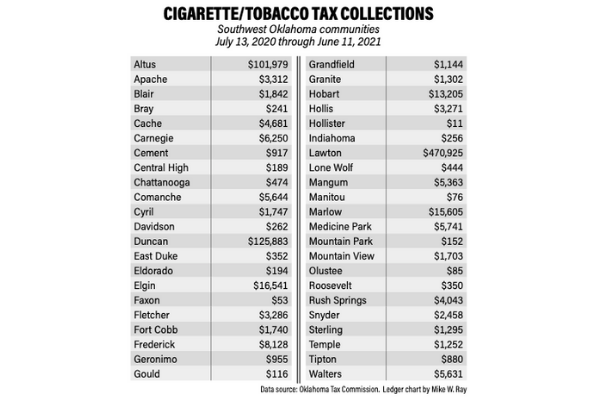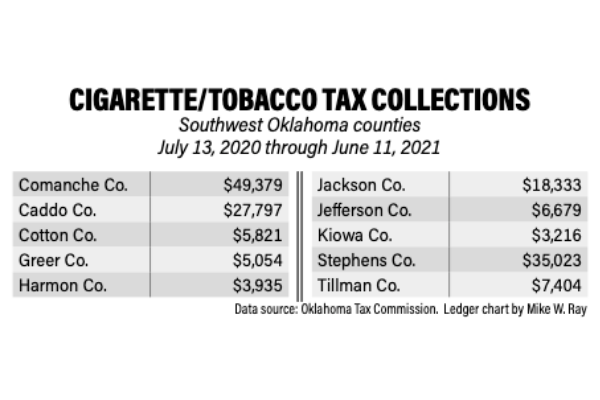OKLAHOMA CITY – Even after 20 years of “significant investment” in anti-smoking programs by the Tobacco Settlement Endowment Trust (TSET), sales of cigarettes and other tobacco products in Oklahoma generated $362 million in tax revenue last year.
In Fiscal Year 2020 the state’s cigarette tax produced $276.2 million and the tobacco products tax produced $62.8 million, Oklahoma Tax Commission ledgers show. In addition, cigarette/tobacco payments under Native American tribal compacts totaled $23.2 million.
Those tax receipts were earmarked for cancer research and treatment, tobacco prevention and cessation, trauma care assistance, Oklahoma State University Osteopathic Medicine, the Health Care Enhancement Fund, the Mental Health and Substance Abuse Fund, the Health Employee and Economy Improvement Fund, the Oklahoma Health Care Authority, the Oklahoma Teachers Retirement Fund, the House Bill 1017 Education Reform and Revenue Fund, the state’s General Revenue Fund, Oklahoma cities and towns, and a sinking fund to retire Oklahoma building bonds.
LEGISLATORS CAST DOUBT ON TSET
The state Legislative Office of Fiscal Transparency (LOFT) issued a report Monday that cast doubt on the effectiveness of TSET’s programs and services.
LOFT reported that Oklahoma’s ranking for tobacco use remains one of the worst in the nation. Oklahoma ranks eighth highest in spending among states (based on percent of Centers for Disease Control and Prevention recommended spending), and its cigarette excise tax ranks 17th in the nation, but Oklahoma ranks 40th when it comes to adult smoking prevalence and 44th in youth smoking prevalence.
Also, Oklahoma has made progress to reduce smoking prevalence but continues to lag national trends, with an adult smoking prevalence rate of 18.9% compared to 15.9% nationally. Regionally, Oklahoma has the fourth highest smoking rate.
In 2019, according to the LOFT analysis, the smoking rate for Oklahoma Medicaid recipients was approximately 25.8%, and 18.9% of the state in general.
One of TSET’s signature programs, the Oklahoma Tobacco Helpline, spends approximately five times more per smoker for cessation services than the national average ($11.52 vs. national average of $2.21 and regional average of $2.55), the legislators reported.
TSET reported that during 28,547 tobacco users registered for services from the Oklahoma Tobacco Helpline in Fiscal Year 2020. “This is somewhat lower than what was observed in FY19,” the agency acknowledged.
While TSET’s Helpline reports positive outcomes, LOFT continued, “it reaches just 3% of Oklahoma’s smokers” – and of those callers, approximately one-third reportedly quit smoking. Furthermore, the percentage of Helpline callers who register for services “also declines year after year,” the LOFT analysis relates.
Oklahoma still ranks among the worst states for critical health outcomes. TSET’s health strategy prioritizes three critical outcomes focused on improving the health of Oklahomans: obesity, cardiovascular disease deaths and cancer deaths. Yet Oklahoma ranks 46th among states when examining measures of health, the LOFT report says. “Compared to other states, Oklahoma has the highest cardiovascular disease death rate and ranks fourth highest for both cancer death rates and obesity rates.”
Also, for every dollar spent by Oklahoma on media and marketing, the tobacco industry spends $17, LOFT said.
Director Julie Bisbee responded that TSET’s programs and services “have saved 42,000 lives, avoided $1.24 billion in health costs, and we’re investing in prevention, which means stopping the problem before it starts.”
TSET’s budget for the current Fiscal Year 2021 has been $46 million, Public Information Director Thomas Larson said.
TSET’s ORIGINS
Then-Oklahoma Attorney General Drew Edmondson filed a lawsuit against Big Tobacco in 1996 for predatory marketing and egregious efforts to normalize smoking. Within two years 45 other states had filed similar lawsuits, and four of the largest tobacco companies agreed to negotiate a national settlement, the Master Settlement Agreement.
As part of the agreement the tobacco industry was forced to end its efforts to target youth. Advertising, marketing and promotional activities were curtailed and the tobacco industry was banned from using cartoons, transit advertising and most forms of outdoor advertising to promote cigarettes. The Master Settlement Agreement also banned branded merchandise, free product samples (except in adult-only facilities) and most sponsorships by tobacco companies.
As part of the Master Settlement Agreement, states receive an annual payment from the tobacco industry so long as cigarettes are sold nationally.
After bipartisan support for legislation to create a state question to amend the Oklahoma Constitution, voters in 2000 approved creation of the Oklahoma Tobacco Settlement Endowment Trust, making Oklahoma the first state to protect its Master Settlement Agreement payments in a constitutional trust.
Each annual payment is divided three ways: 75% is deposited in the Tobacco Settlement Endowment Trust, and the remaining 25% of the annual payment is split between the Legislature, which receives 18.75% for its Tobacco Settlement Fund, and the Attorney General’s office, which receives 6.25% for ongoing enforcement of Master Settlement Agreement provisions.
As of October 2020, Master Settlement Agreement payments to Oklahoma totaled $1.6 billion, and the balance in the TSET endowment was $1.3 billion, Larson said.
From 2000 to 2020, TSET received almost $1.09 billion from the interest earnings on the corpus, the Legislature received more than $397 million, and the AG’s Office received $76.59 million.
The interest earnings on the corpus are used to fund grants and programs to improve the health of Oklahomans of all ages.




